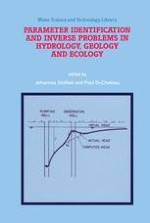1996 | OriginalPaper | Chapter
Evaluation of Different Boundary Conditions for Independent Determination of Hydraulic Parameters Using Outflow Methods
Author : T. Zurmühl
Published in: Parameter Identification and Inverse Problems in Hydrology, Geology and Ecology
Publisher: Springer Netherlands
Included in: Professional Book Archive
Activate our intelligent search to find suitable subject content or patents.
Select sections of text to find matching patents with Artificial Intelligence. powered by
Select sections of text to find additional relevant content using AI-assisted search. powered by
Measuring pressure induced water outflow in combination with inverse modeling is a suitable method to determine the hydraulic properties of soil columns. To study the dependence of the inverse method on the imposed experimental boundary conditions, cumulative water outflow from a soil column is simulated numerically. The column is assumed to be homogeneous with a height of 15 cm. Boundary conditions chosen for the bottom of the soil column are: one-step (OS), multi-step (MS) and linear (LPD) pressure decrease in time. Hydraulic properties are described by the closed forms proposed by van Genuchten (1980). Sensitivity coefficients for each of the parameters α, n, θ s , K s , and τ together with response surfaces for different parameter combinations are estimated for each of the boundary conditions. Then, the influence of random errors in the outflow data on the performance of the different boundary conditions is examined. It is shown that the MS-method is the only one resulting in unique estimates of all parameters investigated. The LPD- and MS-method are comparable if θ s and K s are not optimized simultaneously. The OS-method is very sensitive to the magnitude of the pressure step. A large step may lead to non-unique solutions of the inverse problem, caused by correlations between most of the parameters. Reducing the step leaves only the parameters n and θ s as not identifiable.
